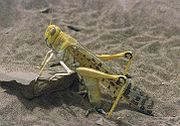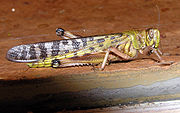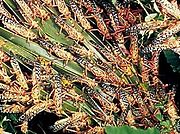
Desert locust
Background Information
SOS Children made this Wikipedia selection alongside other schools resources. Click here to find out about child sponsorship.
| Desert Locust | |
|---|---|
 |
|
| Desert Locust | |
| Scientific classification | |
| Kingdom: | Animalia |
| Phylum: | Arthropoda |
| Class: | Insecta |
| Order: | Orthoptera |
| Suborder: | Caelifera |
| Family: | Acrididae |
| Genus: | Schistocerca |
| Species: | S. gregaria |
| Binomial name | |
| Schistocerca gregaria Forsskål, 1775 |
|
Plagues of the Desert Locust (Schistocerca gregaria) have threatened agricultural production in Africa, the Middle East and Asia for centuries. The livelihood of at least one-tenth of the world’s human population can be affected by this voracious insect. The Desert Locust is potentially the most dangerous of the locust pests because of the ability of swarms to fly rapidly across great distances. It has two to five generations per year. The northern highlands of Ethiopia (Tigray) and Eritrea slow the movements of desert locusts to the breeding areas of the Red Sea coast. Potential desert locust plagues originating in east Africa can be prevented if action is taken during or before localized outbreaks in Eritrea and Sudan (Jahn 1993 ). The 2004 desert locust outbreak has caused significant crop losses in West Africa and had a negative impact on food security in the region. While the Desert Locust alone is not responsible for famines, it can be an important contributing factor.
Desert Locust ecology
The Desert Locust lives a solitary life until it rains. Rain causes vegetation growth and allows the female to lay eggs in the sandy soil. The new vegetation provides food for the newly hatched locusts and provides them with shelter as they develop into winged adults.
When vegetation is distributed in such a way that the nymphs, usually called hoppers, have to congregate to feed, and there has been sufficient rain for a lot of eggs to hatch, the close physical contact causes the insects' hind legs to bump up against one another. This stimulus triggers a cascade of metabolic and behavioural changes that cause the insects to transform from the solitary form to the gregarious form. When the hoppers become gregarious they change from green coloured to yellow and black, and the adults change from brown to red (immature) or yellow (mature). Their bodies become shorter, and they give off a pheromone that causes them to be attracted to each other, enhancing hopper band and subsequently swarm formation. Interestingly, the nymphal pheromone is different from the adult one. When exposed to the adult pheromone, hoppers become confused and disoriented, because they can apparently no longer "smell" each other, though the visual and tactile stimuli remain. After a few days, the hopper bands disintegrate and those that escape predation become solitary again. It's possible that this effect could aid locust control in the future.
During quiet periods, called recessions, Desert Locusts are confined to a 16-million-square-kilometers belt that extends from Mauritania through the Sahara Desert in northern Africa, across the Arabian Peninsula, and into northwest India. Under optimal ecological and climatic conditions, several successive generations can occur, causing swarms to form and invade countries on all sides of the recession area, as far north as Spain and Russia, as far south as Nigeria and Kenya, and as far east as India and southwest Asia. As many as 60 countries can be affected within an area of 32-million-square-kilometers, or approximately 20 percent of the Earth's land surface.
Locust swarms fly with the wind at roughly the speed of the wind. They can cover from 100 to 200 kilometers in a day and will fly up to about 2,000 meters above sea level (thereafter, it becomes too cold). Therefore, swarms cannot cross tall mountain ranges such as the Atlas Mountains, the Hindu Kush or the Himalayas. They will not venture into the rain forests of Africa nor into central Europe. However, locust adults and swarms regularly cross the Red Sea between Africa and the Arabian Peninsula and are even reported to have crossed the Atlantic Ocean from Africa to the Caribbean in ten days during the 1987-89 plague. A single swarm can cover up to 1200 square kilometers and can contain between 40 and 80 million locusts per square kilometer. The locust can live between three to six months, and there is a ten to sixteenfold increase in locust numbers from one generation to the next.
Crop loss
Desert Locusts can consume the approximate equivalent of their body mass each day (2 g) in green vegetation: leaves, flowers, bark, stems, fruit, and seeds. Nearly all crops, and non crop plants, are at risk, including pearl millet, rice, maize, sorghum, sugarcane, barley, cotton, fruit trees, date palm, vegetables, rangeland grasses, acacia, pines, and banana. What is more, locust droppings are toxic, and spoil any stored food that is left uneaten.
Crop loss from locusts was noted in the Bible and Qur'an; these insects have been documented as contributing to the severity of a number of Ethiopian famines. During the twentieth century, Desert Locust plagues occurred in 1926-1934, 1940-1948, 1949-1963, 1967-1969, 1987-1989 and 2003-2005. The significant crop loss caused by swarming desert locusts exacerbates problems of food shortage, and is a threat to food security.
Control
Early warning and preventive control is the strategy adopted by locust affected countries in Africa and Asia to try to stop locust plagues from developing and spreading. FAOs Desert Locust Information Service (DLIS) in Rome, Italy monitors the weather, ecological conditions and the locust situation on a daily basis. DLIS receives results of survey and control operations carried out by national teams in affected countries and combines this information with satellite data such as MODIS, rainfall estimates and seasonal temperature and rainfall predictions to assess the current situation and forecast the timing, scale and location of breeding and migration up to six weeks or more in advance. The situation assessments and forecasts are published in monthly locust bulletins that date back to the 1970s. These are supplemented by warnings and alerts to affected countries and the international community. Those since the 1990s are available on the FAOs Locust Watch web site [www.fao.org/ag/locusts]. FAO also provides information and training to affected countries and coordinates funding from donor agencies in case of major upsurges and plagues.
The Desert Locust is a difficult pest to control, and control measures are further compounded by the large and often remote areas (16-30 million km²) where locusts can be found. Undeveloped basic infrastructure in some affected countries, limited resources for locust monitoring and control, and political turmoil within and between affected countries further reduce the capacity of a country to undertake the necessary monitoring and control activities.
An ecological method to control Desert Locust is with natural enemies. These include predatory and parasitic wasps and flies, predatory beetle larvae, birds, and reptiles. The downside is that they are easily overwhelmed by the sheer magnitude of most swarms and bands if these were to be the only defense used in a serious outbreak. However, they can help poor farmers since they might change the direction the swarm is heading. Another old African method is by putting poisonous or aromatic plants next to the crop they are trying to protect.
At present the primary method of controlling desert locust infestations is with insecticides applied in small concentrated doses by vehicle-mounted and aerial sprayers at Ultra-Low Volume (ULV) rates of application. The insecticide is usually acquired by the insect via secondary pick-up (i.e. walking over or eating the residue on a plant). Control is undertaken by government agencies in locust affected countries or by specialised organisations like the Desert Locust Control Organisation for East Africa (DLCO-EA).
Biopesticides
Biopesticides include fungi, bacteria, neem extract and pheromones. The effectiveness of many biopesticides equals that of conventional chemical pesticides, but there are two distinct differences. Biopesticides take longer to kill the insect, plant diseases or weeds, between 2 and 10 days. More importantly, while there are approximately 25 million cases of severe work-related pesticide poisoning in developing countries each year, biopesticides are usually harmless to other creatures and the environment.
There are two types of biopesticides - biochemical and microbial. Biochemical pesticides are similar to naturally occurring chemicals and are non-toxic, such as insect pheromones use to locate mates, while microbial biopesticides like Green Muscle come from bacteria, fungi, algae or viruses that either occur naturally or are genetically altered. Entomopathogenic fungi generally suppress pests by mycosis: causing a disease that is specific to the insect.
A biological control product has been under development since the late nineties. It is based on a naturally occurring entomopathogenic fungus (i.e. insects-infecting fungus) , Metarhizium anisopliae var. acridum. The species M. anisopliae is widespread throughout the world infecting many groups of insects, but it is harmless to humans and other mammals and birds. The variety acridum has specialised on short-horned grasshoppers, to which group locusts belong, and has therefore been chosen as the active ingredient of the product.
The product is available in Africa under the name Green Muscle and in Australia as Green Guard. It is applied in the same way as chemical insecticides but does not kill as quickly. At recommended doses, the fungus can take up two weeks to kill up to 90% of the locusts. For that reason, it is recommended for use mainly against hoppers, the wingless early stages of locusts. These are mostly found in the desert, far from cropping areas, where the delay in death does not result in damage. The advantage of the product is that it affects only grasshoppers and locusts, which makes it much safer than chemical insecticides. Specifically, it allows the natural enemies of locusts and grasshoppers to continue their beneficial work. These include birds, parasitoid and predatory wasps, parasitoid flies and certain species of beetles. Though natural enemies cannot prevent plagues, they can limit the frequency of outbreaks and contribute to their control. Biopesticides are also safer to use in environmentally sensitive areas such as national parks or near rivers and other water bodies.
Green Muscle was developed under the LUBILOSA project which was initiated in 1989 in response to environmental concerns over the heavy use of chemical insecticides to control locusts and grasshoppers during the 1987-89 plague. The project focused on the use of beneficial disease-causing microorganisms ( pathogens) as a biological control agent for grasshoppers and locusts. These insects were considered to be too mobile and to reproduce too fast to be readily controlled by classical biological control. Pathogens have the advantage that many can be produced in artificial culture in large quantities and be used with ordinary spraying equipment. Entomopathogenic fungi were traditionally seen as needing humid conditions to work well. However, the LUBILOSA project found a way to avoid this by spraying fungal spores in an oil formulation. Even under desert conditions, Green Muscle can be used to kill locusts. During recent trials in Algeria and Mauritania (2005 and 2006), various natural enemies, but especially birds, were abundant enough to eliminate treated hopper bands in about a week, because the diseased hoppers became sluggish and easy to catch.
2003-2005 Desert Locust upsurge
From October 2003 to May 2005, West Africa faced the largest desert locust outbreak in 15 years. The upsurge started as small independent outbreaks that developed in Mauritania, Mali, Niger and Sudan in the autumn of 2003. Two days of unusually heavy rains that stretched from Dakar, Senegal to the Morocco in October allowed breeding conditions to remain favourable for the next six months and the Desert Locusts rapidly increased. Lack of rain and cold temperatures in the winter breeding area of Northwest Africa in early 2005 slowed down the development of the locusts and allowed the locust control agencies to stop the cycle. During the upsurge, nearly 130,000 km² were treated by ground and aerial operations in more than 20 countries. The costs of fighting this upsurge have been estimated by the FAO to have exceeded US$400 million and harvest losses were valued at up to US$2.5 billion which had disastrous effects on the food security situation in West Africa.
The countries affected by the 2004 outbreak were Algeria; Burkina Faso; the Canary Islands, Cape Verde; Chad; Egypt; Ethiopia; The Gambia; Greece; Guinea; Guinea Bissau; Israel; Jordan; Lebanon; Libyan Arab Jamahiriya; Mali; Mauritania; Morocco; Niger; Saudi Arabia; Senegal; Sudan; Syria; Tunisia.



